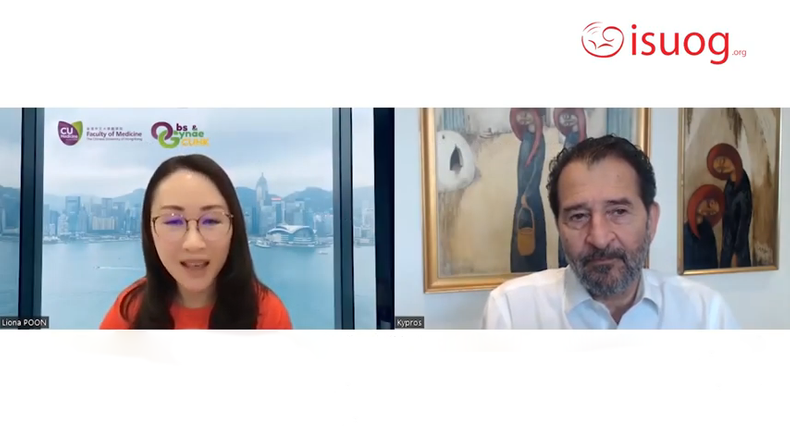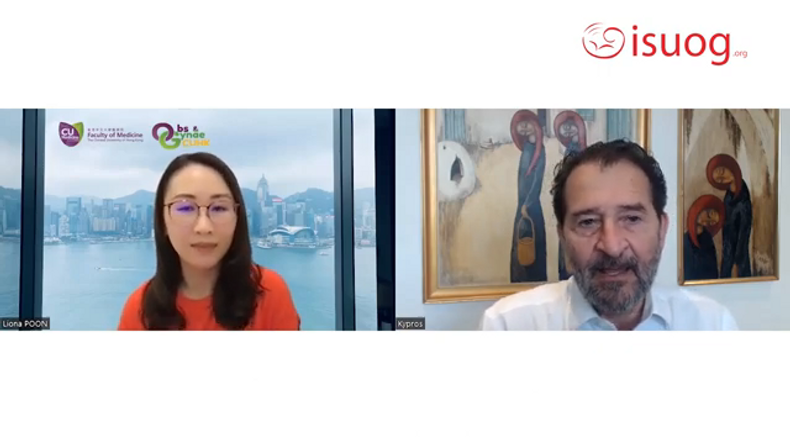May is 'Pre-eclampsia Awareness Month', and this month ISUOG's Ask the Expert - Patient Perspectives series features specially selected clinical expert panellists, Prof. Kypros Nicolaides and Prof. Liona Poon. In these compelling videos, Prof. Nicolaides and Prof. Poon answer the questions surrounding pre-eclampsia that matter most to our community's patients.
Pre-eclampsia (PE) is condition that affects 2–5% of pregnant women, and as high as 8–12% in some countries in Africa, with 76,000 women globally losing their life to PE every year. In light of May's World Pre-eclampsia Day, ISUOG has compiled a collection of resources from our community's expert clinicians including, screening for PE, the best strategy for managing hypertension and PE at end of pregnancy, and risk assessment for PE.
Series Videos
Pre-eclampsia: Patient Perspectives Part 3
Pre-eclampsia: Patient Perspectives Part 3
Ask the Expert: Uncut
Questions for Our Panellists
Why can pre-eclampsia be so serious?
Pre-eclampsia complicates about one in 100 pregnancies, and yet it is one of the major causes of death and handicap short-term and long-term adverse events, both for the mother and for the child. On a worldwide basis, you have about 46,000 maternal deaths every year and more than half a million fetuses and babies die as a result create pre-eclampsia.
Prof. Kypros Nicolaides
Who is at risk of developing pre-eclampsia?
Unfortunately, all women are at risk of developing pre-eclampsia and there are certain groups of women that have a particularly high risk, and those are defined by various maternal demographic characteristics, plus previous obstetric and medical history. The maternal characteristics are increasing maternal age and weight, and race has an important contribution. We know that certainly from studies that we carried out in England, women that are black and South Asian have a considerably higher risk of developing pre-eclampsia than women that are white. The contribution of genetic versus environmental factors remains part of the debate. But until we resolve this issue, the truth is that certain races have a higher risk than others.
Then we go to the particulars of the pregnancy. How did you conceive? If you had in-vitro fertilization, your risk is higher. If we then go to previous obstetric and medical history; do they start off their pregnancy with diabetes, chronic hypertension, or auto- immune diseases? In relation to previous pregnancies, women that had previous pregnancies complicated by pre-eclampsia are also an increased risk. So there's a series of maternal factors that identify as a group of women that are at higher risk than average.
Prof. Kypros Nicoaides.
Do you advocate for screening based on maternal factors, or should we do something else?
In the 70s when you had screening for Down's, based on maternal age, the detection rate was about 30% and in the subsequent decades, the detection rate went to beyond 90%. When you combine information from the maternal history together with biochemical and physical markers. Exactly the same is true for the screening for preeclampsia. With these maternal risk factors and the overall detection rate of pre-eclampsia, the proportion of pre-eclampsia that is predictable is only about 30 to 40%. Yet we have carried out extensive studies in which we showed that the measurement of blood pressure, the measurement of uterine artery pulsarity index markers, together with biochemical markers like placental growth factor. When you combine this information, then we are now reaching detection rates in excess of 90%. So yes, if you have nothing else, maternal risk factors are tolerable, recognizing that their performance in identifying the high risk group is quite poor. Ideally, and now after 20 years of extensive research and extensive evidence, I think we should be moving towards a combined process; history, maternal factors together with biomarkers.
Is it safe to take aspirin for pre-eclampsia?
There are ways of preventing pre-eclampsia. Extensive studies now have shown that if we screen in the first trimester to identify the high risk group and we give them aspirin of 100mg per day from the 12th to the 56th week of pregnancy, we can have a substantial reduction in the proportion of women that develop the most severe types of pre-eclampsia that require preterm birth. There are some suggestions that perhaps we should give aspirin to everybody and not bother screening. I think that would be wrong, because we know that, in big population studies, aspirin can increase considerably the risk of death from hemorrhagic events in the brain and the gastrointestinal tract. The appropriate way of doing things is to screen, and then treat the high risk group.
Aspirin is useful for the prevention of preterm pre-eclampsia, but it doesn't have any significant effects on the incidence of term pre-eclampsia. Unfortunately, term pre-eclampsia is three times as common as preterm pre-eclampsia, although it has less adverse effects for the mother and the baby, because it has a greater contribution overall.
Prof. Kypros Nicolaides
What is the effectiveness of pravastatin on pre-eclampsia?
For higher risk groups, unfortunately pravastatin did not have an impact in reducing the rate of pre-eclampsia in our study. Future research will address the question of whether having identified a very high risk group in the third trimester, by advocating early delivery, we would reduce the rate of term pre-eclampsia.
Prof. Kypros Nicolaides
Is calcium effective in preventing pre-eclampsia?
Another major impact in the intervention in the prevention of pre-eclampsia, that unfortunately is confined only to countries that are deficient in calcium intake, is supplementation of the diet with calcium. In such countries, it was reported that calcium reduces the rate of both preterm and term pre-eclampsia by about 50%. It has not been shown to have any beneficial effects in places where there is no calcium deficiency.
Prof. Kypros Nicolaides
How does a woman recognize that she may be developing pre-eclampsia?
Symptoms of pre-eclampsia include headache, visual disturbances, nausea, vomiting, abdominal pain, vaginal bleeding, reduced fetal movements, some swelling in the feet, hands, and even the face, and frothy urine. Most importantly, patients with pre-eclampsia can be entirely asymptomatic, hence there's importance of assessment of blood pressure and proteinuria during antenatal visits.
Prof. Liona Poon
If delivery is the cure of pre-eclampsia, when can we apply this approach?
We believe that the delivery of the placenta is the only cure for pre-eclampsia, so there is a need to deliver the baby at the same time. Whether we need to do the delivery following the diagnosis of pre-eclampsia depends on several factors, including the severity of the disorder, whether there's an associated fetal growth restriction with abnormal Dopplers and the gestational age at diagnosis. So, if the patient is diagnosed in early gestation - for example, 28 weeks - then there's a desire to prolong her pregnancy to improve lung maturation of the baby, provided that the maternal condition allows. If the patient is diagnosed with pre-eclampsia at term, the aim is to prevent progression of the disorder and eclampsia; hence, we tend to advise delivery. So I think, timing of delivery has to be individualized for each patient and we can't apply one rule for all.
Prof. Liona Poon
Is there a risk of pre-eclampsia persisting after delivery?
Indeed, following the delivery of the pregnancy, the risk of progression of pre-eclampsia and the risk of eclampsia persist. So I would say that, the woman is not out of the woods, we must monitor closely for hypertension and treat proactively with antihypertensive, and watch out for impending eclampsia.
Pre-eclampsia: Read, Watch and Learn
ISUOG has compiled a collection of resources from our community's expert clinicians, including screening for PE, the best strategy for managing hypertension and PE at end of pregnancy, and risk assessment for PE. Read, watch and learn here:
Expert Voice: Pre-eclampsia




